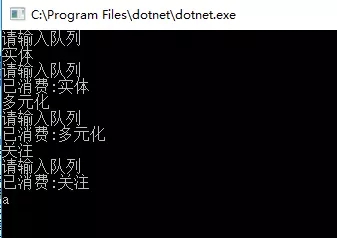本篇文章为大家展示了如何在.NetCore中使用BlockingCollection实现一个消息队列,内容简明扼要并且容易理解,绝对能使你眼前一亮,通过这篇文章的详细介绍希望你能有所收获。
消息队列现今的应用场景越来越大,常用的有RabbmitMQ和KafKa。
我们用BlockingCollection来实现简单的消息队列。
BlockingCollection实现了生产者/消费者模式,是对IProducerConsumerCollection<T>接口的实现。与其他Concurrent集合一样,每次Add或Take元素,都会导致对集合的lock。只有当确定需要在内存中创建一个生产者,消费者模式时,再考虑这个类。
MSDN中的示例用法:
using (BlockingCollection<int> bc = new BlockingCollection<int>())
{
Task.Factory.StartNew(() =>
{
for (int i = 0; i < 1000; i++)
{
bc.Add(i);
Thread.Sleep(50);
}
// Need to do this to keep foreach below from hanging
bc.CompleteAdding();
});
// Now consume the blocking collection with foreach.
// Use bc.GetConsumingEnumerable() instead of just bc because the
// former will block waiting for completion and the latter will
// simply take a snapshot of the current state of the underlying collection.
foreach (var item in bc.GetConsumingEnumerable())
{
Console.WriteLine(item);
}
}实现消息队列
用Vs2017创建一个控制台应用程序。创建DemoQueueBlock类,封装一些常用判断。
HasEle,判断是否有元素
Add向队列中添加元素
Take从队列中取出元素
为了不把BlockingCollection直接暴漏给使用者,我们封装一个DemoQueueBlock类
/// <summary>
/// BlockingCollection演示消息队列
/// </summary>
/// <typeparam name="T"></typeparam>
public class DemoQueueBlock<T> where T : class
{
private static BlockingCollection<T> Colls;
public DemoQueueBlock()
{
}
public static bool IsComleted() {
if (Colls != null && Colls.IsCompleted) {
return true;
}
return false;
}
public static bool HasEle()
{
if (Colls != null && Colls.Count>0)
{
return true;
}
return false;
}
public static bool Add(T msg)
{
if (Colls == null)
{
Colls = new BlockingCollection<T>();
}
Colls.Add(msg);
return true;
}
public static T Take()
{
if (Colls == null)
{
Colls = new BlockingCollection<T>();
}
return Colls.Take();
}
}
/// <summary>
/// 消息体
/// </summary>
public class DemoMessage
{
public string BusinessType { get; set; }
public string BusinessId { get; set; }
public string Body { get; set; }
}添加元素进队列
通过控制台,添加元素
//添加元素
while (true)
{
Console.WriteLine("请输入队列");
var read = Console.ReadLine();
if (read == "exit")
{
return;
}
DemoQueueBlock<DemoMessage>.Add(new DemoMessage() { BusinessId = read });
}消费队列
通过判断IsComleted,来确定是否获取队列
Task.Factory.StartNew(() =>
{
//从队列中取元素。
while (!DemoQueueBlock<DemoMessage>.IsComleted())
{
try
{
var m = DemoQueueBlock<DemoMessage>.Take();
Console.WriteLine("已消费:" + m.BusinessId);
}
catch (Exception ex)
{
Console.WriteLine(ex.Message);
}
}
});查看运行结果

上述内容就是如何在.NetCore中使用BlockingCollection实现一个消息队列,你们学到知识或技能了吗?如果还想学到更多技能或者丰富自己的知识储备,欢迎关注亿速云行业资讯频道。
免责声明:本站发布的内容(图片、视频和文字)以原创、转载和分享为主,文章观点不代表本网站立场,如果涉及侵权请联系站长邮箱:is@yisu.com进行举报,并提供相关证据,一经查实,将立刻删除涉嫌侵权内容。